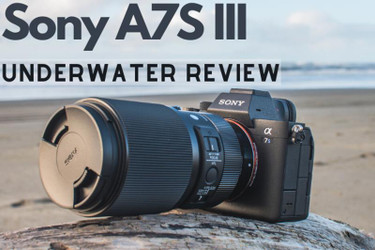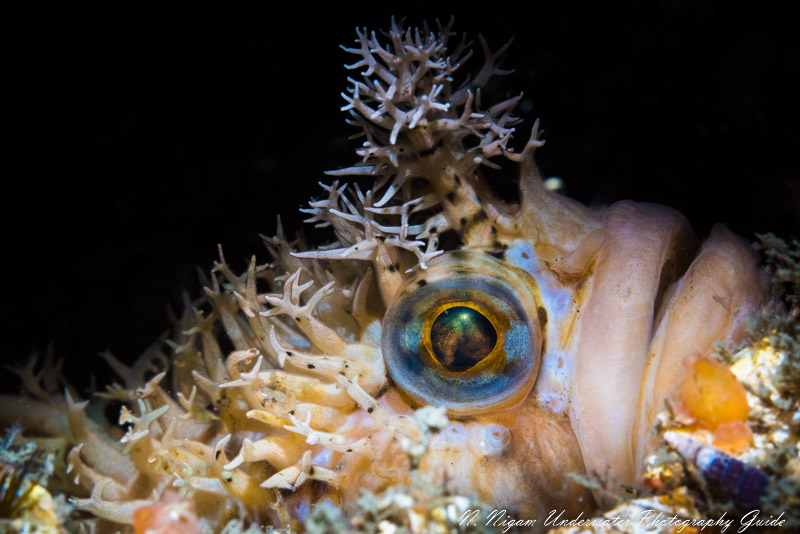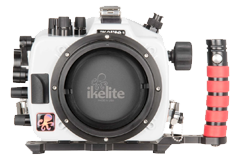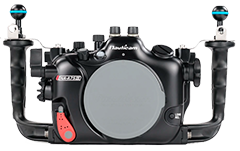Sony A7S III Underwater Review
December 9th, 2020
Sony A7S III Underwater Review
The Sony A7S III is a spectacular video-oriented full-frame mirrorless camera that is shaping up to be 2020's best camera for underwater video. It's a testament to the fact that Sony listens to its consumers and delivers. Rather than blowing the specs out of proportion like Canon did with the still amazing Canon EOS R5, Sony released a solid workhorse built for any video workflow and arguably undersold its ability. The A7S III is our favorite underwater video camera because of the wide range of options available from frame rates to bit rates and codecs to picture profiles.
The A7S III can record 4K video up to 120fps for slow motion and stable video, with 10-bit 4:2:2 internal recording for the best color science Sony has to offer when paired with a wide variety of Log profiles. It is also an excellent stills camera with 12 megapixels of resolution - enough for social media and most day-to-day usage - but likely not enough for working photographers that shoot macro or print large prints. Sony didn't hold back when it came to autofocus options, equipping the camera with Sony's excellent AF tracking and animal eye AF capability. True to form, the A7S III succeeds the A7S II as a low light masterpiece, it's ability bolstered by a lower resolution sensor and close to "dual gain" ISO (more on that below). Finally, unlike the Canon EOS R5, the A7S III does not have recording time limits and did not overheat in our underwater tests, despite some topside users complaining about overheating in direct sunlight. We took the Sony A7S III diving in the dark, cold waters of the Olympic Peninsula in some of the harshest, surgiest dive conditions mother nature could muster, and are, by-and-large, extremely pleased with the results.
Status: Shipping Now!
U.S. MSPR: $3,498
Sony A7S III Body
Order a Sony A7S III underwater housing at Bluewater Photo:
Nauticam Sony A7S III Underwater Housing
Ikelite Sony A7S III Underwater Housing
Sea & Sea Sony A7S III Underwater Housing
Aquatica Sony A7S III Underwater Housing
Isotta Sony A7S III Underwater Housing
Marelux Sony A7S III Underwater Housing
Order a Sony A7S III Camera Body at Bluewater Photo:
Read Our Top Sony A7S III Underwater Settings
Check out our full Sony A7S III Underwater Housing Buyer's Guide
Contact Us for a Special Sony A7S III Underwater Package
Jump to a Section
Sony A7S III vs Canon EOS R5 | Sony A7S III Specifications | Sony A7S III Features
Sony A7S III for Underwater Video | Sony A7S III for Underwater Photo | Sony A7S III Underwater Settings
Best Lenses | Best Sony A7S III Underwater Housings | Conclusion
Sony A7S III vs the Canon EOS R5
Sony A7S III in an Ikelite A7S III Housing Post-Dive
The Sony A7S III and Canon EOS R5 are often compared as being the two best video oriented prosumer hybrid mirrorless cameras on the market. That being said, it's difficult to compare the two cameras as they fill different niches. The R5 features 8K video @ 30fps and internal RAW recording - both features that aren't available in the A7S III. Like the A7S III, the R5 is also equipped with 4K @ 120fps. The highest resolution on the A7S III is 4K as the resolution is limited by the number of pixels on the sensor. But that's where most of the video comparisons end. The R5 is really a better choice for photographers and video shooters that need the ability to crop 8K video. So macro video shooters might be initially inclined to look at the R5.
But the A7S III is a camera that's designed for much more practical video usage. First off, it doesn't overheat as quickly as the EOS R5. The A7S III can shoot 4K @ 120 fps for at least an hour at room temperature whereas the EOS R5 can shoot at that frame rate for only 15 minutes. For most applications, the A7S III is going to be the better choice. There are no official recording limits on the A7S III, so if you can keep the camera cool, it will keep recording. During our underwater tests, we found the EOS R5 overheated after 20-30 minutes of continuous shooting in 8K. Now that's a lot of data, more than most people can handle, and on most dives your R5 shouldn't overheat. We only video on most of our dives with the A7S III and it never got close to even having an overheating warning. That was with 4K @ 60p and 4K @ 120p 10-bit 4:2:2 internal recording. We are confident that the A7S III won't overheat underwater despite some users complaining about overheating in direct sunlight in 90F temperatures.
The other reason that the A7S III can be more practical for underwater video usage is because of the wide range of workflow options available. Unless you want to shoot RAW video, where the R5 can record that internally, the A7S III has more logarithmic recording profiles to choose from. This makes it a more versatile video camera for different lighting situations. If you want to shoot RAW video with the A7S III, you can, but you will need an external recorder. Please see our Sony picture profile recommendations below. The A7S III also allows you to shoot with H.265 and H.264 compression options so you can decide how much data you'd like to collect over time.
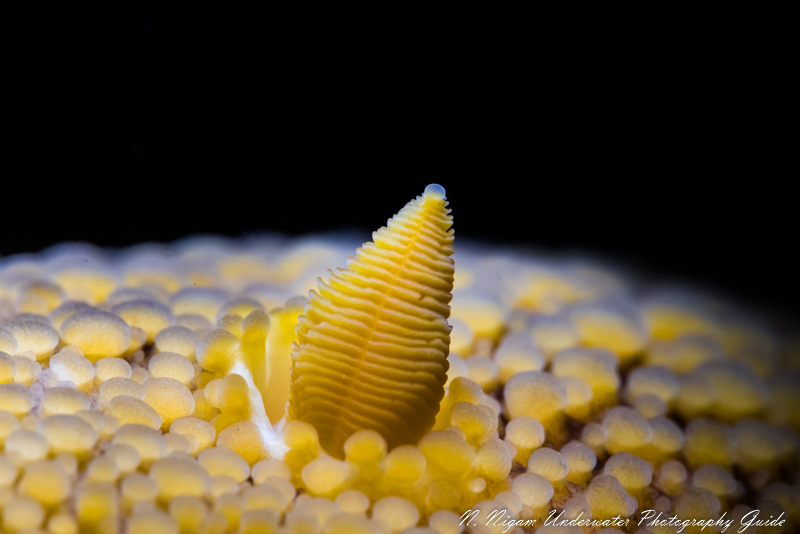
This nudibranch rhinophore was captured with the Sigma 105mm macro, Sony A7S III camera, Ikelite A7S III housing, and Kraken +13 diopter. f/22, 1/160, ISO 100
Finally, the reason it's difficult to compare the two cameras is that the A7S III boasts much better low light performance than the R5. This is because the R5 is a high resolution photo camera which by design can't perform well in low light due to a large number of pixels. Because many underwater shooting environments have low light, we recommend the A7S III for video shooters for smoother, more detailed video. The A7SIII is built in with equivalent technology to dual gain ISO where at ISO 12,800 the camera boosts the signal to the digital analog converter resulting in lower noise and a "second base ISO." We found this extremely useful for shooting S-Log.
The one area where we felt the R5 has a leg up on the A7S III is autofocus. Although the AF is great on the A7S III, the R5's animal eye AF tracking when shooting macro video worked pretty well with some fish. The animal eye AF on the A7S III never activated during our tests. Other than that feature, both AF systems are very similar in speed.
Who should buy the Canon EOS R5?
The Canon EOS R5 is a better option for photo-oriented shooters who want great video as well. It's a great camera for those who are not planning on recording 20-30 minutes straight at high frame rates and resolutions. It's also a great option for macro video shooters who want an additional crop factor that they can apply in post processing on 8K video. These shooters should have a computer system that can handle processing 8K footage. Finally, the EOS R5 is a better option for those that want some animal eye AF tracking capability in video modes.
Who should buy the Sony A7S III?
The Sony A7S III is a better option for most underwater video shooters who don't intend to shoot 8K and don't need 8K for the cropping ability it provides. The A7S III has better options for logarithmic profiles and workflow than the EOS R5. Most importantly, there is a much lower risk of the A7S III overheating and there are no recording time limits. Finally, the A7S III has amazing low light video performance that almost every underwater shooter can appreciate. Who wouldn't want minimal noise at ISO 12,800?! If you do need to take photos, the A7S III's photo capability is awesome and on par with other alpha cameras. Just be prepared for smaller 12 megapixel files.
This high ISO photo was taken with limited lighting. The A7S III did an amazing job! Sony A7S III in an Ikelite A7S III housing, Canon 8-15mm wide lens, dual Sola 15,000 video lights. 1/125, f/13, ISO 1250
Sony A7S III Specifications
- 12 MP BSI CMOS Full Frame Sensor
- Bioz XR Image Processor
- ISO 80-102,400
- "Low Base" and "High Base" (effectively dual gain) ISO capability for better low light shooting
- 4K video up to 120 fps
- No recording time limits. Could be limited by heat (4K @ 60p for at least an hour)
- 10-bit 4:2:2 internal recording
- S-LOG, HLG, Cine logarithmic picture profiles available
- 4K @ 60p, 16-bit RAW recording with an external recorder
- 5 axis in-body image-stabilization (IBIS)
- Dual card slots (either SD or CFexpress Type A)
- 9.44 M dot Electronic Viewfinder (EVF) - the best resolution on the market!
- Movie File Formats: XAVC S (Long GOP, H.264 MP4); XAVC HS (Long GOP, H.265 HEVC); XAVC S-1 (All-Intra, H.264 MP4)
- AF tracking with human and animal eye AF capability
- 759 point hybrid AF system with 425 contrast detection points
- 3" 1.44 million dots LCD
- Weight: 21.7 oz (617g) with batteries
- Size: 5.1 X 3.8 X 2.7 in (129 X 97 X 70mm)
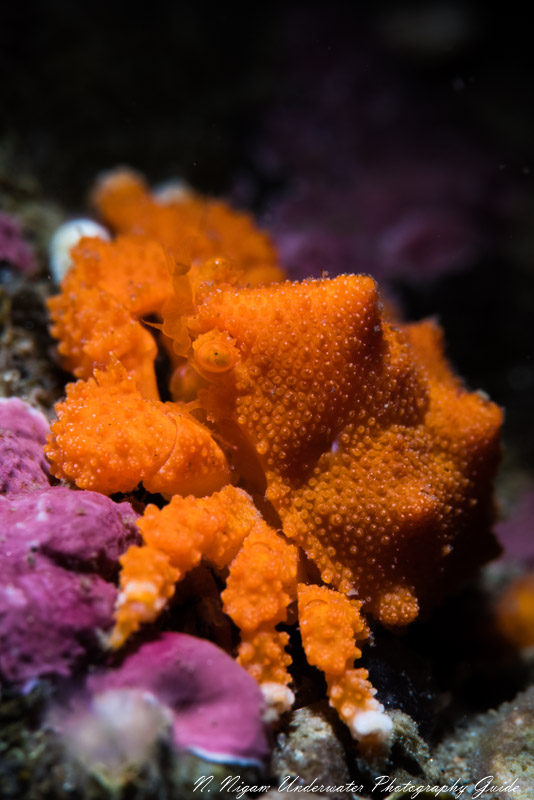
A juvenile puget sound king crab photographed with the Sony A7S III, Ikelite A7S III housing, Sigma 105mm macro. f/20, 1/125, ISO 320.
Key Sony A7S III Features
Build Quality, EVF, Battery Life, and Ergonomics
The A7S III is built very similarly to other alpha cameras. However, it's important to note that it does not share the body of the Sony A7 III or A7R III - it is an entirely different camera. True to form, the A7S III has 4 custom buttons and most of the buttons on the camera are customizable. This makes it our favorite camera on the market for customizing your workflow, which is especially useful for underwater shooting. Please check out our top recommended Sony A7S III underwater settings for recommended customizations. We think the ergonomics of the camera are excellent for topside shooting, with a very useful joystick for AF point selection, and touch AF to go along with it. However, the mode dial is in need of an update, as it is still dominated by photo-oriented settings. It would be very nice to see a new mode dial where you can change video modes instead of photo modes. The D-Pad on the back of the camera is also equipped with a dial which makes it easy to change ISO, shutter speed, and aperture with the three control dials. Unfortunately, you can't customize the D-Pad to select AF points which would be very useful for underwater shooters.
The body itself is built like a rock and has a slightly improved grip from earlier alpha models. The screen rotates outward for vlogging and the electronic viewfinder (EVF) has the best resolution we have had the pleasure of experiencing yet! If you like shooting through viewfinders rather than off the LCD, you'll be very pleased to use the A7S III. However, most video shooters are usually going to want to use the LCD underwater. One of our favorite aspects of the body is the dual card slots that accept both UHS-II and CFExpress Type A cards. We highly recommend using CFExpress Type A if you are going to shoot video with this camera because of the fast write speeds.
When it comes to battery life, we feel that it is better than the Canon EOS R5. We could get about three dives on one battery shooting video most of the time. That's excellent battery usage. If you are just shooting photos with this camera, you can likely get up to four dives on one battery.
There are a few important ergonomic concerns that we have with this camera. Foremostly, the AF joystick and touch screen are the only two ways to select AF points on the camera. Some housings offer joystick compatibility and some don't. Please contact us if you need help finding a housing that does. If you decide to get a housing that doesn't have joystick compatibility, there are a few workarounds for selecting AF points. We recommend shooting with AF tracking in photo mode, and using an AF/MF toggle customized button in video mode. That way, you can position your subject in the center and toggle to MF when it is locked on and recompose. We talk about this in more detail in our A7S III settings article.
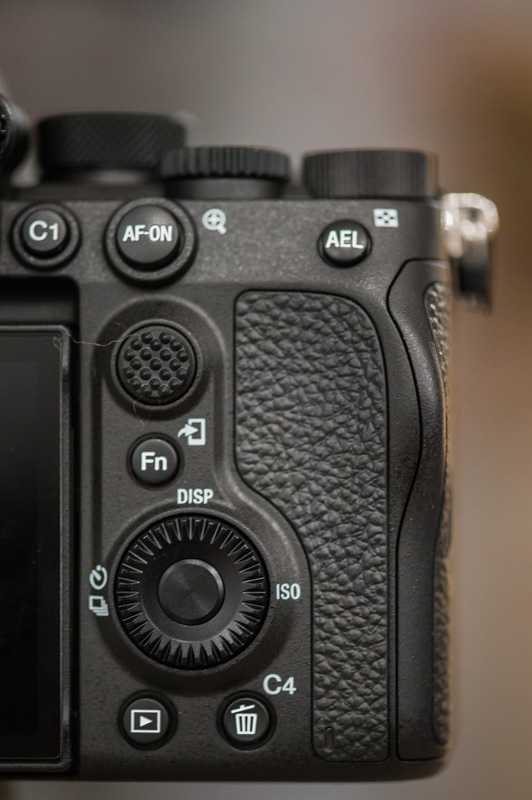
Sony A7S III Buttons and Dpad
A New and Improved Menu System!
It's no secret that Sony menus are some of the worst on the market. Well, with the A7S III's menu update, now they are not! The menu is now more intuitive and easier to navigate. The color coding and description of menu items have greatly improved and we found it a pleasure to use underwater. Sony still has a long way to go in creating the perfect menu, but if you are a current Sony shooter, you will be happier with the new menu.
Image Quality and Low Light Capability
The Sony A7S III is equipped with a 12 megapixel BSI CMOS full-frame sensor. Yes, it's a low resolution sensor, but that's what makes it such a masterpiece of a video camera. Rather than processing extra pixels into a 4K image, the A7S III has a 1 to 1 pixel readout and focuses processing power on frame rates, bit rates, and compression. Lower resolution sensors are also much more capable in low light by design. We obtained very useable video at ISOs at 16,000 and beyond. The A7S III's ability to reduce noise in video is almost magical. That makes it a great tool for shooting with logarithmic profiles that require higher base ISOs. The A7S III also has a built in "high base" and "low base" ability that works similarly to dual gain ISO. It allows you to shoot with lower noise at ISO 12,800 than you would have at ISO 10,000. We found this very useful when shooting at low video light power levels with critters that are skittish with S-Log2 and S-Log3.
When it comes to photo quality, the A7S III remains a low noise machine and we had no problem shooting at ISOs 800 and higher. This became especially useful when we used a pair of Sola 15,0000 pro video lights to take still photos. 12 megapixels might not be a lot of resolution for large prints and other professional applications, but it is more than enough for social media, websites, youtube thumbnails and day to day usage. We were very happy with the clarity, detail, and dynamic range in all of our photos. The A7S III might not be a photo camera, but the image quality is certainly not bad either.
Three large fish eating anemones photographed with the Sony A7S III, Ikelite A7S III housing, dual Ikelite DS 161 strobes, Ikelite to Sony TTL converter, and Canon 8-15mm fisheye lens. f/18, 1/125, ISO 500
5 Axis In-Body Image-Stabilization (IBIS) and Steady Shot Modes
The 5 axis IBIS with the A7S III functions about as well as other Sony alpha cameras. It could certainly be improved and it's not nearly as well as the IBIS on the Canon EOS R5. Even the Nikon Z6 and Z7 have better IBIS. That being said, it still functions much better than a camera without IBIS. In video modes, we recommend using active steady shot. While it does crop the image slightly, it adds digital stabilization for an even smoother image. We didn't find it to be warpy like it can be with other cameras. If you have your camera on a tripod, then standard steadyshot can be just fine.
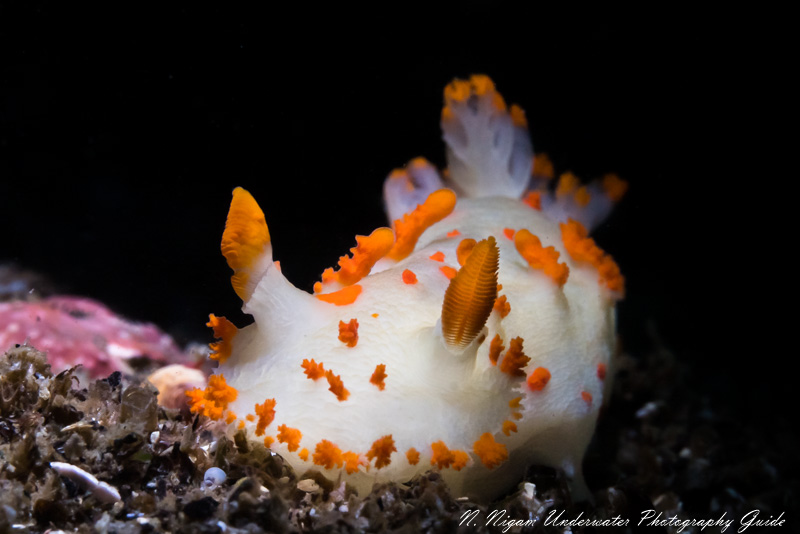
Sony's IBIS allowed us to get crips photos of this clown dorid in high surge. Photographed with the Sony A7S III, Ikelite A7S III housing, Sigma 105mm macro lens. 1/160, f/22, ISO 320
Autofocus System
The autofocus system on the A7S III is top of the line. In fact, it's just about as good as the system on the Sony A7R IV which currently has our favorite autofocus system. The AF tracking ability in photo mode is excellent. You can select any point to track and the camera follows the point without an issue. However, we did notice that the animal eye AF didn't activate at any point in our tests, so we think the EOS R5's animal eye AF feature is more developed.
When it comes to video, it is not possible to set an AF tracking point in video mode underwater. The wide autofocus area mode also does a poor job in locating a good AF point for macro video. It does a better job for wide angle video. Therefore, we recommend locking in your focus point and then switching to manual focus for macro video. However, if you have a tripod and a housing that has joystick compatibility, you may be able to use a spot AF area and move it around with the joystick. If you do shoot with manual focus, we recommend turning on the peaking display and changing the color to red to better visualize what areas of the video are in focus. Please see our settings article for more detail on this.
Fast autofocus with the Sony A7S III is the only way to capture a photo of a decorated warbonnet. Photographed with a Sony A7S III, Ikelite A7S III underwater housing, Sigma 105mm macro. f/18, 1/160, ISO 200
Sony A7S III for Underwater Video
When it came to the A7S III, Sony didn't veer away from the goal of designing the best prosumer hybrid video camera on the market. It beats out competitors like the Pansonic S-series with better lens options and the Canon EOS R5 with better engineering, workflow, and recording times. The 12 megapixel BSI CMOS sensor makes it an extremely capable low light video camera with large pixels. The "high base/low base ISO" function provides dual "native" ISO equivalents so that you can shoot in really low light with limited noise. When it comes to practical applications, this is an essential feature for capturing video in overhead, nighttime, and low light environments. It also means high performance and easy color grading when shooting with S-Log picture profiles. It will enable videographers to shoot in Log profiles without too much noise in the shot. Macro videographers are bound to be excited for the ability to shoot 16 bit 4K video, albeit to an external recorder. It's wonderful being able to capture the full spectrum of color that is displayed by some of the wild and wonderful critters found on reefs and in muck. We also loved being able to shoot 10-bit 4:2:2 internal, knowing that our S-Log footage was going to be easy and accurate to color grade. For videographers trying to shoot quick moving subjects in tumultuous water (e.g., surfers, sea lions, sharks, bait balls), Sony's IBIS and 120 frames per second @ 4K provides excellent stability - especially with the new active steadyshot mode. Action shooters will be able to create slow motion clips in crisp resolutions. And if you ever find yourself with a corrupt card, dual CFExpress card slots are a lifesaver. Finally, Sony's S-Log profiles and RAW recording capability mean that you can edit and color grade your video with the ultimate creative experience. What more could you want in an underwater video camera?
Video Recording Options and File Types
One of the most compelling reasons to purchase the A7S III is the wide range of frame rates, bit rates, codecs, file types, and picture profiles for different video workflows.
Selecting Your Resolution
The Sony A7S III is one of the world's best full-frame mirrorless 4K video cameras. As such, you probably bought it to shoot 4K video. Even if you don't intend to shoot in 4K, we recommend shooting in 4K so that you can crop your video in post processing if necessary. The 4K video quality is very sharp. However, we should note that if you want to use super 35 mode for a better crop, you will need to shoot in HD.
Resolution and File Type Selection
Selecting Your Codec
The file format, or codec, you choose will determine how much your video is compressed and the bit rates you can shoot at. An uncompressed codec will take up more space on your hard drive, but it will also be easier for your computer to process as it will have to do less work decoding. So the more compressed your video is, the more time you should plan on spending in post. Here are the three codecs available to you when shooting 4K.
1. XAVC HS 4K - This is the most compressed codec and we generally don't recommend using it unless you need to save a lot of space and want to spend more time in post processing. It uses an H.265 compression standard that some graphics cards may have trouble handling.
2. XAVC S 4K - This is Sony's standard file type, and the codec that will suit the widest range of needs. You will be able to shoot 120 fps with this file type and vary your bit rates quite a bit. We recommend this file type for most video shooters. It uses an H.264 compression standard that should be relatively easy to handle with standard editing softwares and graphics cards.
3. XAVC S-I 4K - Ths is the least compressed file type available. It will be easier to playback, but it will also create large file sizes. It features a bit rate of 600M 10bit 4:2:2 at 60fps - that's a lot of data!
Selecting Your Frame Rate and Recording Setting
Your frame rate determines how many frames the A7S III captures in a second. A higher frame rate creates less motion blur in the shot and allows you to slow down your footage so that you can stabilize it. Higher frame rates also require more data and take up more space on your card. For underwater shooting, we highly recommend shooting at a high frame rate because the 3D environment that water introduces is exceptionally shaky. We recommend shooting in 4K @ 60p for most underwater video. But if you are in a very quick situation, especially in open water (e.g., sharks, bait balls, dolphins), we recommend shooting at 120p. This will allows you to slow your video down even more and is considered true slow motion. That being said, 120p will take up a lot of data so use it sparingly.
After selecting your frame rate, you'll want to choose your bit depth and bit rate. If you are shooting Log picture profiles like S-Log2 and S-Log3 then we recommend selecting 10-bit 4:2:2 for the most accurate color gamut. If you are shooting the standard picture profile then 8-bit 4:2:0 should be sufficient for the data that you need. In most cases, youtube compression will eliminate the benefits of 10-bit 4:2:2 if you are using it with the standard picture profile.
Recommended Video Recording Picture Profiles
Standard (No Picture Profile) - We recommend the standard picture profile if you don't want to do much color grading or post processing. Sony's standard picture profile is quite nice, but you need to be accurate with your exposure and white balance when you shoot with the standard profile.
S-Log2 - S-Log2 offers the most detail out of the Log profiles with the least risk for introducing noise compared to other S-Log profiles. It is more difficult to edit than HLG or Cine profiles, but it can produce some of the best results. S-Log2 must be shot at a minimum of ISO 800. Try to use this profile in situations with a lot of light. We recommend overexposing your scene rather than underexposing.
S-Log3 - S-Log3 offers more detail in the shadows than S-Log2 but it can be more difficult to work with and introduce more noise as well. S-Log3 must be shot at a minimum of ISO 800. Try to use this profile in situations with a lot of light. We recommend overexposing your scene rather than underexposing.
HLG3 - HLG3 is our top recommended Log profile. It's easier to work with than S-Log2 and allows you to shoot at lower ISOs down to ISO 200.
Cine2 - Cine2 is a good hybrid between a Log profile and standard profile which makes it the easiest Log profile to work with in post. This is a good middle ground if you want to do some work in post but not a lot.
Sony A7S III for Underwater Photo
The Sony A7S III has much more photo capability than the A7S II did. It was gifted with many of the recent improvements in autofocus, processing, and EVF build quality that has been included in recent Sony cameras like the A7R IV. The only area it's really lacking in is resolution with a 12 megapixel sensor. That being said, shooting at ISO's results in very little noise, so it could still be a good photography option for cold water photographers that only need photos for social media and websites. 12 megapixels won't yield much cropping capability for macro photographers, so be wary of that as well. Beyond the sensor size, the state of the art AF tracking makes the A7S III one of the quickest and best performing cameras on the market when it comes to autofocus. It is also very capable in low light down to -6 EV. We took advantage of this in the dark, cold water that we were diving in and found that it focused slightly better in low light than the EOS R5. Overall, the A7S III is a capable stills camera, and we don't see much reason why a dedicated video shooter would need another camera for stills. The A7S III is a true hybrid camera.
Even the most common subjects, like this purple sea urchin, can produce art. This photo was taken with a Sigma 105mm f/2.8 DN DG Art Macro lens, Sony A7S III, Ikelite A7S III housing, Saga magic tube, and reefnet fiber optic snoot. f/20, 1/160, ISO 200
Best Sony A7S III Underwater Settings
There are so many options and settings available on the Sony A7S III that it can leave your head spinning. Thankfully, we have put together our favorite settings for underwater photos and videos in a "relatively" concise article. Check it out!
Best Underwater Lenses for the Sony A7S III
In recent years, Sony has gone from having a limited supply of lenses for underwater photography to one for the best repertoire of native lenses for full-frame mirrorless cameras on the market. Sony A7S III users have an excellent set of choices for shooting macro, wide, mid-range, and fisheye.
Wide-Angle Lenses
The Sony 16-35mm F4 lens is the top wide-angle lens choice for photo and video. If you’re looking for something even wider to get nice close-focus wide-angle (CFWA) shots of reefs there are a couple of options for shooting fish-eye. The 28mm prime lens with a fisheye conversion lens will give the widest possible angle of view. The fisheye conversion lens can be used behind a large or small dome port, while the Sony 16-35 mm F4 lens is recommended for use with an 8-inch dome or larger.
Wet wide-angle lenses are a great option with this camera. We recommend the Nauticam wet wide-angle lens or the Kraken KRL-01 wet wide-angle lens with the 28mm prime lens. All of these options are very sharp and will result in stunning wide-angle photos.
Mid-Range Lenses
The Sony 24-70mm F 4 or the Sony 28-70mm F3.5-F5.6 are good choices along with the 35mm F2.8 portrait lens.
Macro Lenses
For underwater photography, the Sony 90mm macro prime lens is the best choice for small fish and macro subjects. It is exceptionally sharp and produces high quality images. A 50mm macro lens is another great option, though it doesn't focus as quickly as the Sony 90mm.
The Sigma 105mm f/2.8 DN DG Art macro lens is a new lens that we tested during this review. We highly recommend it for the Sony A7S III, though there is some focus breathing that video shooters should be aware of. Check out our full review of the Sigma 105mm here!
This elusive longfin sculpin was easily captured with the Sigma 105's quick AF speed. This photo was taken with a Sigma 105mm f/2.8 DN DG Art Macro lens, Sony A7S III, Ikelite A7S III housing. f/18, 1/160, ISO 200
Canon Lenses
Canon lenses can be attached to the Sony A7S III with the Metabones, Sigma MC-11, or Photodiox adapters, but auto-focus is generally better with Sony lenses. Lenses like the Canon 8-15mm, 16-35mm, and 17-40mm work well. You can also use the Canon 100mm macro lens.
We did our review with a Canon 8-15mm fisheye lens and a metabones adapter, behind the Ikelite 8 inch compact dome port for close focus wide angle. Unfortunately, we noticed that the autofocus with this set up is very slow. We only recommend using the Canon 8-15mm if you intend to shoot slow scenes or plan on shooting with manual focus.
Top Underwater Housings for the Sony A7S III
Currently there are three excellent housing options out for the Sony A7S III and we anticipate more to come to the market soon. Ikelite offers an excellent, lightweight polycarbonate housing. Nauticam and Marelux offer a high-quality aluminum housing for the Sony A7S III. Due to the differences in body design, different housings are necessary for the A7S III, A7III, and A7S II.
Ikelite Sony A7S III Housing
The Ikelite Sony A7S III 200DL Underwater Housing is built from a high quality, corrosion free ABS-PC blend polycarbonate housing which makes it sturdy and impervious to corrosion. The housing offers full control of the camera with controls that are designed to be easy to use. This housing is great for anyone looking for an amazing price point. The Ikelite Sony A7S III housing features a clear back so you can easily monitor the housing for any leaks. The built-in vacuum system adds an extra level of protection from such events. This housing does not have full compatibility with the joystick, please see our settings article for AF point selection workarounds.
Nauticam Sony A7S III Housing
The Nauticam Sony A7S III Underwater Housing is built from aircraft grade aluminum which makes it durable and lightweight. Camera controls are very easy to access with buttons, levers, and knobs all within easy reach. It also comes with a vacuum valve pre-installed for ultimate peace of mind. Nauticam housings are universally popular and this housing is rated to 100 meters depth.
Marelux Sony A7S III Underwater Housing
This Marelux underwater housing is built from high-grade aluminum alloy which provides durability and can withstand even the toughest beatings. Ergonomics are also top-notch, all camera controls are readily available at your fingertips and all buttons are clearly labeled. Thanks to its small size, it is great to travel with. Assembling the housing itself and installing a camera is a breeze with its quick release plate so you can spend more time under the water and less time setting up your gear. With a depth rating of 100m, this housing is an excellent option for both recreational divers as well as technical divers.
Check out our full Sony A7S III Housing Guide
Conclusion
There's no doubt in our minds that the Sony A7S III is the best underwater video camera to come out this year. The images and video that we captured speak for themselves. In fact, we think the Sony A7S III is a better option for dedicated underwater video shooters than the Panasonic GH5, Panasonic S-5, Canon EOS R5, Canon EOS R6, and the Nikon Z6II. The A7S III's low light performance with both autofocus speed and noise reduction is unrivaled in the hybrid camera market. Moreover, the A7S III is the best video option on the market for video shooters that need specific workflows with the option to shoot Log video, different codecs, frame rates and resolution. While the camera's resolution is limited to 4K, we think this is the best resolution for most applications and the camera does not seem to overheat when shooting underwater over the course of a dive. Although stabilization could be improved when compared to the Canon EOS R5, the A7S III's new active steady shot setting is great for handheld shooters, especially in wide angle underwater scenes. Finally, the enhanced ergonomics and menu system on the A7S III are a major improvement that will allow underwater video shooters to select and customize settings seamlessly underwater. It's a great time to be a videographer and we're very optimistic about the future. Year after year we've watched video technology improve well beyond photo technology, and we can't wait to see what Sony comes up with next!
This photo of a nudibranch was taken with a Sony A7S III, Ikelite A7S III Housing, Sigma 105mm f/2.8 DN DG Art Macro lens. f/18, 1/160, ISO 200
Gear Used in This Review
- Ikelite Sony A7S III Underwater Housing
- Sony A7S III camera body
- Sigma 105mm macro lens
- Canon 8-15mm fisheye lens (but we recommend the Sony 16-35mm lens due to slow autofocus)
- Sola 15,000 advanced kit
- Ikelite DS 161 strobes
- Ikelite to Sony TTL Converter
- Saga Magic Tube
Order a Sony A7S III underwater housing at Bluewater Photo:
Nauticam Sony A7S III Underwater Housing
Ikelite Sony A7S III Underwater Housing
Sea & Sea Sony A7S III Underwater Housing
Aquatica Sony A7S III Underwater Housing
Isotta Sony A7S III Underwater Housing
Marelux Sony A7S III Underwater Housing
Order a Sony A7S III Camera Body at Bluewater Photo:
Check out our full Sony A7S III Underwater Housing Buyer's Guide
Contact Us for a Special Sony A7S III Underwater Package
Learn more here:
https://www.bluewaterphotostore.com/
Contact our sales department:
Phone: 310-633-5052
Email: sales@bluewaterphotostore.com

